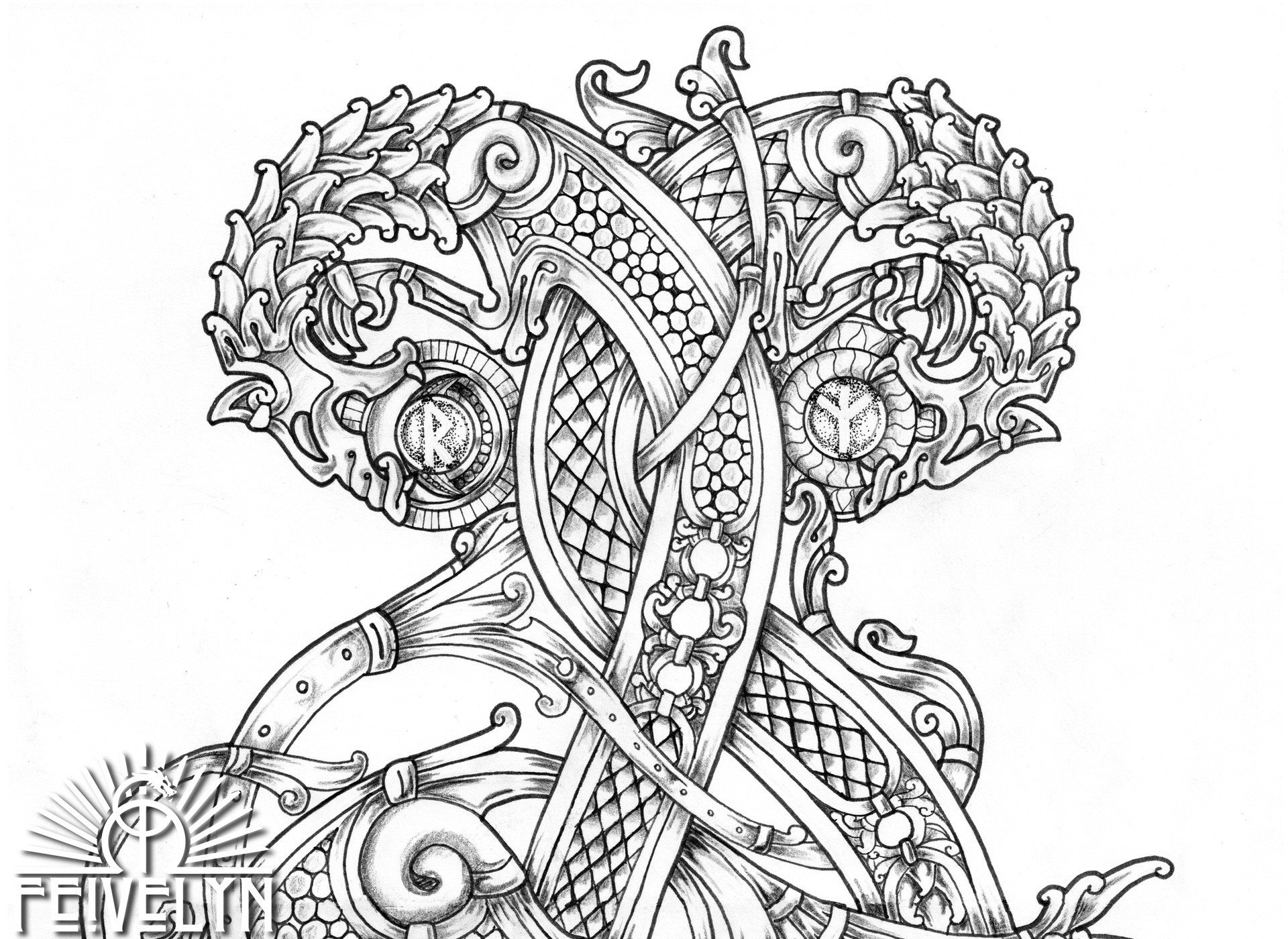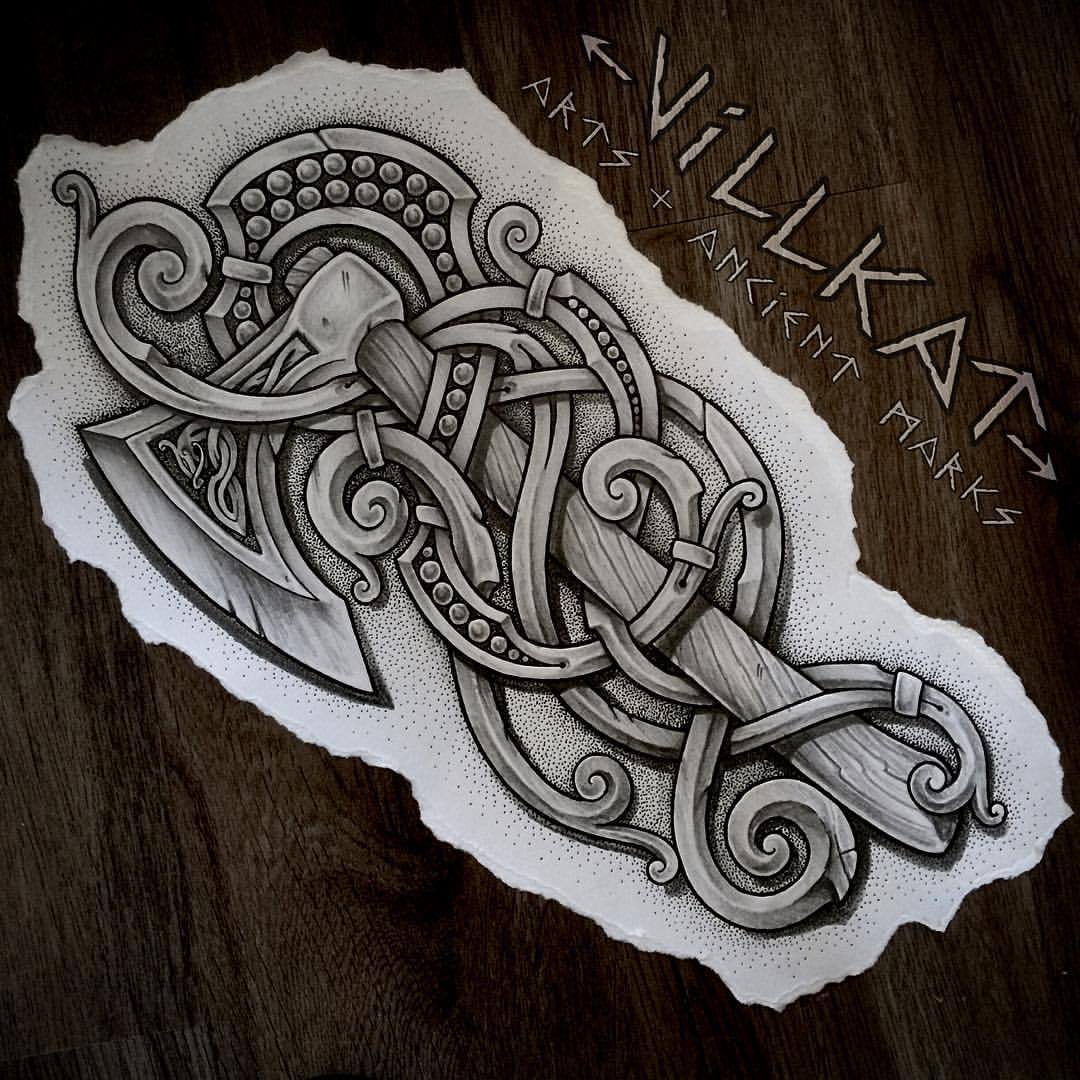
ArtStation Norse Knotwork Designs
Viking knotwork, also known as interlace, is a style of decorative art that originated in the early medieval period. It is believed to have been inspired by the intricate knotwork designs found in Celtic art, which the Vikings encountered during their raids and travels. The Vikings quickly adopted this style and incorporated it into their own art.

norse knots Google Search design Pinterest Tattoo
In this video, you'll learn what the core differences in the looping schemes are between the Mammen, Ringerike and Urnes styles.Learn more about the Viking a.

Stands Tall Creations Woodcarving Studio and Gallery Viking ornament
Viking Knots Norse Vikings made use of imagery and symbols to a great extent in their daily lives. They decorated the walls of their homes with these and their armor, weapons and clothing all featured beautiful and unique designs and imagery such as Viking knots. Here is all our articles on those designs and their meanings.

Celtic Knots Collection Stock Illustration Download Image Now iStock
She and others interpret the Valknut, with its knot-like appearance, as a symbolic expression of this idea. [4] This explanation is all the more plausible since the form of heathen Norse magic that the sources mention the most often, namely seidr, used imagery related to spinning and weaving fiber to symbolize altering the course of events.

norse knots Google Search Art viking, Tatouage viking, Celtique
May 18, 2019 - Tatto ideas and patterns for wood and leather working. See more ideas about viking art, knotwork, celtic designs.

Norse Mythology Viking Knotwork Viking knotwork, Viking embroidery
The ax head was carved, then inlayed with silver. On one side of the axe head is a foliate pattern and on the other is a stylized, ribbon-like bird with tendrils on wings and tail. Ringerike. The first half of the 11th century featured the Ringerike style in Viking art. Lion-shaped beasts still appear as well as plant motifs and foliate patterns.

Vintage viking border Royalty Free Vector Image
3.1 The Oseberg Style 3.2 The Borre Style 3.3 The Jellinge Style 3.4 The Mammen Style 3.5 The Ringerike Style 3.6 The Urnes Style 4 Contemporary Viking Art 5 Frequently Asked Questions 5.1 What Is the Difference Between Celtic and Norse Knotwork? 5.2 Why Is Most Viking Art Found Outside of Scandinavia? Exploring Traditional Viking Art and Norse Art

viking designs medieval tattoo arm band tattoo border design tattoo
The Valknut can also be interpreted as knots for those slain in combat. It referred to Viking warriors brought to Valhalla and are linked to Odin's Valkyries. Celtic patterns are closely related to Norse patterns since they represent a way of life. The Celtic knot represents the three forces of nature: water, fire, and earth. It consists of a.

Norse Patterns
Why Did Both the Celts and the Norse Use Knots? Both the Celtic and Nordic cultures used knotwork: in their pottery, in their paintings, and even in their tattoos. But as these two cultures were often at odds historically, how did they come to share this beautiful form of art? And most importantly, which should you choose to emblazon your AleHorn?

Viking Knotwork by Lariethene on DeviantArt
The Viking Age started around 793 to 1066 CE with the notable 793 CE invasion of the Holy Island of Lindisfarne in Northumberland, North East England. This was the onset of the Viking invasions and the severity of what these "Northmen" were capable of.

Viking Axe Drawing at GetDrawings Free download
A place for free and open discussion of all things Norse Pagan. We foster an environment of open discourse, as long as we keep it civil; Ad hominems, harassment, discrimination, and advocating for violence will be deleted. We can discuss these things, unless goes against having the civility and the grith of this sub.

Jormungandr The Midgard Serpent Traditional Norse Knotwork Art,
2,702 viking knot pattern stock photos, 3D objects, vectors, and illustrations are available royalty-free. See viking knot pattern stock video clips Filters All images Photos Vectors Illustrations 3D Objects Sort by Popular Celtic-Scandinavian design. Old Norse pattern, frame, isolated on black, vector illustration

celtic zoomorphic coloured designs Google Search Norse tattoo
The word 'valknut' is derived from two different words: 'valr' meaning slain warrior and 'knut' meaning knot. According to Norse faith, in Valhalla (the Hall of the Slain), Odin, the god of death and war in Norse mythology, would welcome the warriors slain/killed in battle.

142 best images about Norse Art on Pinterest Viking dragon, Church
The intricate knotwork and zoomorphic designs of Celtic art were influenced by Norse styles, resulting in a fascinating blend of two distinct artistic cultures. Furthermore, Viking art had a significant impact on the development of Art Nouveau in the late 19th and early 20th centuries.

Borre Style Viking knotwork, Norse tattoo, Pattern tattoo
Valknut (Knot of the Slain). Nine was a magic number to the Norse, and within the pattern of these lines all the runes can be found. The runes also sprang from the Well of Urd, and carried inherent meaning and power. Thus, when one looks at the nine lines of the Web of Wyrd, one is seeing all the runes at once, and seeing in symbolic form.

Viking and Oseberg influenced knotwork design by TattooDesign on
The Connection Between Viking and Celtic Knots From time to time, you will come across an interesting motif decorating some monument in Europe or being represented as the work of pagans from ancient times. There's a good chance that what you are looking at might be either a Celtic or a Viking knot.